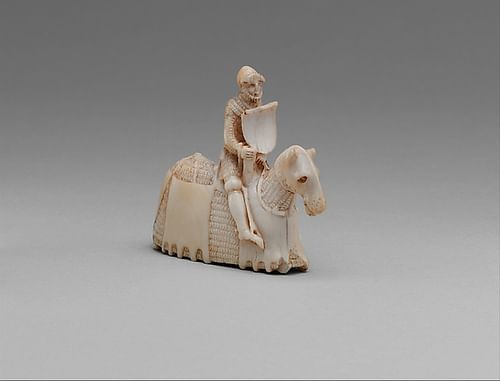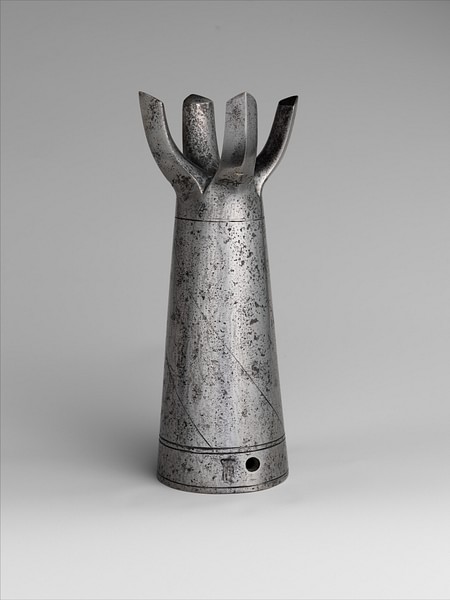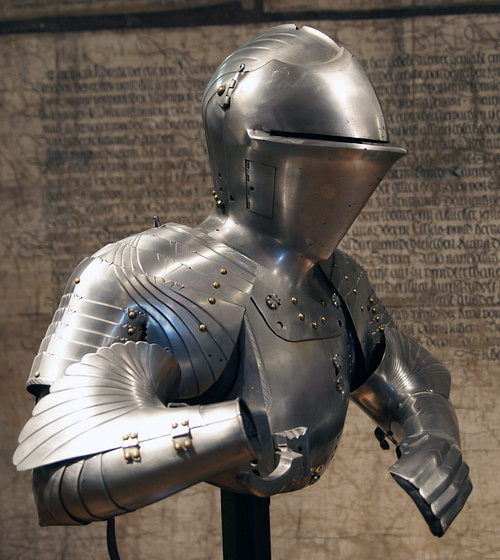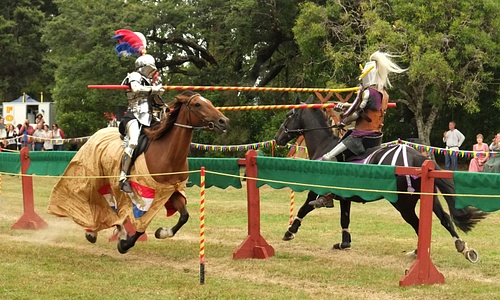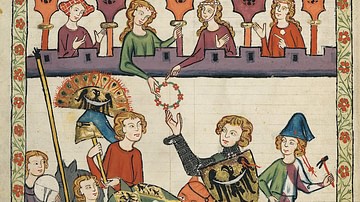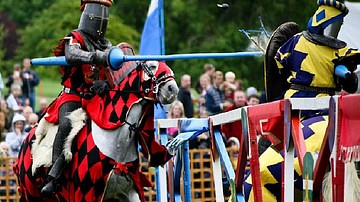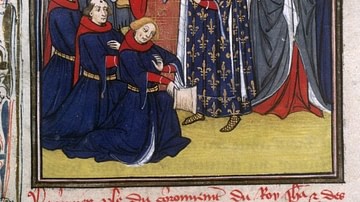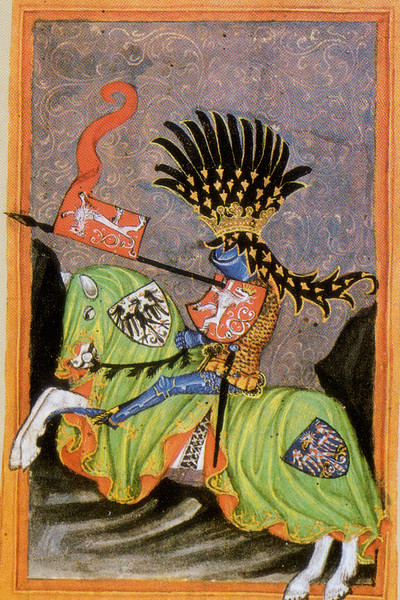
Jousts were, from the 13th to 16th century CE, a popular part of the European medieval tournament where knights showed off their martial skills by riding against one another with wooden lances in a designated area known as the lists. The two opposing knights, from c. 1400 CE, were separated by a barrier or tilt, hence the sport's other name of tilting. Jousting was an important opportunity for heraldic display, general pageantry, and the chance for a knight to impress aristocratic ladies who might show them favour by giving them their scarf or veil. Jousting fell out of fashion by the end of the Middle Ages, but there were occasional revivals up to the 19th century CE.
Tournaments
Tournaments where knights fought in mock cavalry battles (mêlée), with the object of capturing as many of the opposing team as possible, probably began in France in the 11th century CE. By the following century, the trend had spread across Europe. Tournaments might last several days, very often in celebration of another event such as an important marriage or coronation. There were stalls with refreshments, sellers of horses and fine clothes, intermission performances of drama with musicians and acrobats, pageants, and several banquets over the course of the event.
Jousting became more common as an event of the tournament from the second half of the 13th century CE, although it had been a minor side event since the 11th century CE. The name joust perhaps originated from the Latin juxtare ('to meet'), and the event was likely created in response to the greater emphasis on chivalry and honour in the later Middle Ages. It was much easier to display skills in an individual event in front of an audience as opposed to the free-for-all mêlée which took place across the countryside. A good knight was supposed to display such qualities as martial prowess (prouesse) and noble manners (debonnaireté), and those competitors with a criminal background or with a disreputable reputation were banned from competing (which is perhaps why some competed anonymously). As tournaments became ever-more spectacular social events of great pageantry, knights even had to prove their lineage to take part and displaying their family's coat of arms on the shield, surcoat, and horse's coat became the done thing.
Ladies attended jousts, sometimes they even sponsored the tournament itself, and they might give certain token articles, known as favours, to specific knights they favoured such as a veil which was then tied around the receiver's lance. The ladies and other spectators watched from purpose-built stands, pavilions with balconies or simply tents.
Sometimes knights dressed up as such legendary figures as King Arthur, as traditional enemies like the Saracens, as monks, or even court ladies. This was especially so at the event known as the Round Table where knights each pretended to be a character from the Arthur legends. Another opportunity for jousting was during truces or sieges when knights from opposing armies jousted to pass the time, although the results could be lethal. Famous examples of these impromptu jousts occurred in Sicily in 1062 CE, Wurzburg (Germany) in 1127 CE, Rennes in 1357 CE and several times during the English-Scots wars of the 14th century CE.
Weapons
The main weapon was the lance which was around 2.4 to even 3 metres (8-10 ft) in length and commonly made of ash or cypress. A lance was made hollow so that it shattered without causing too much injury. To further reduce fatalities, lances were fitted with a three- or four-pointed head (coronel) in order to reduce the impact and swords were blunted (rebated). Such weapons became known as 'arms of courtesy' or à plaisance. However, there were also grudge matches (a joust á outrance) where the two opponents used lethal weapons and swore to fight until serious injury or death decided the matter.
It was only from the 14th century CE that a vamplate, first circular and then conical, was added to protect the hand carrying the lance. In the 15th century CE, the lance was made thinner where the hand gripped it. A leather strap might be worn around the upper arm to prevent the lance from sliding backwards when striking an opponent.
Even for the normal event, the risk of injury was high and plenty of practice was advisable. A common training device to hone one's lancing skills was the quintain - a rotating arm with a shield at one end and a weight at the other. A knight had to hit the shield and keep riding on to avoid being hit in the back by the weight as it swung around. Sometimes the shield was made into a figure of a sword-wielding Saracen for a bit of extra motivation. Another device was a suspended ring which the knight had to catch and remove with the tip of his lance. Inexperienced knights often had their own jousting events held on the eve of a tournament proper.
Swords were generally not used while still on horseback, but if one knight was dismounted then the other would also leave his horse, and the two could proceed in hand-to-hand combat if they wished. Swords were long and double-edged, with a simple cross-guard to protect the hand; they usually required two hands to swing effectively for any length of time. Maces might be employed rather than swords.
Armour
Although padded linen and leather armour was worn at tournaments in the 13th century CE, when plate armour came into wider use on the battlefield in the following century, so too, it was worn by jousters. Generally, though, battlefield armour became specialised for tournaments with sections likely to be hit (the chest and right side of the helmet or helm) being reinforced with an extra metal plate, a heavy steel gauntlet (manifer) for the lance hand, and a grill for the helmet visor. A popular type of helmet was the 'frog-mouth' (so-called because the bottom half protruded more than the top half) which had a horizontal slit for vision but which was so narrow that a knight could only see out when tilting the head forward; the advantage being his eyes were instantly protected by holding the head up. Towards the end of the 15th century CE helmets started to be screwed to the breast and back armour so that it did not so easily fall off if struck. For tournaments, helmets were often lavishly adorned with plumes and crests, even horns and three-dimensional figures.
Shields were made of wood and leather, usually with iron reinforcing parts. Shields varied in shape and size over time. They could be small like the classic shield of heraldry, elongated or even rectangular. Some shields had a top corner cut out in which the lance could be rested. The shield was sometimes secured to the shoulder by a strap to ensure it did not fall to the ground when struck. In the 15th century CE, knights often wore a poire, which was a pear-shaped padding worn on the shoulder to cushion any blow to the shield held in front of it.
Horses were frequently protected with a padded or metal chest protector (peytral) which hung around the animal's neck. They might also have a metal plate protecting the head and the eyes were very often covered. Saddles were given a higher back (especially in Germany) to make it easier for the knight to stay in it when struck by an opponent's lance. In the 14th century CE, saddles were fitted with curving protectors for the rider's legs which might otherwise be protected by shin-guards. Also by the end of the 14th century CE, knights were wearing a lance rest as part of the breast armour to give the weapon additional stability.
The Lists
The area where knights jousted was known as the lists, a roughly rectangular space usually spread with sand or straw. The length of the field was from 100 to 200 metres (110-220 yards). From the early 15th century CE, the two knights were sometimes separated by a wooden barrier (tilt) running the length of the field which ensured they did not collide head-on. Originating in Italy and replacing the simple rope of former times, the tilt was around 1.8 metres (6 ft) high. Each rider set off from opposite ends of the field and galloped towards each other aiming with their lance to hit the opponent on the chest, throat or helmet which would be usually enough to knock him off his horse. In later jousts, the objective was specifically to hit the shield of the opponent. There were even mechanical shields in the early 15th century CE which shattered when struck, thus clearly indicating to the crowd who had hit who first.
Very often lances broke on impact, a deliberate safety feature, and in such case, the knight's squire provided his master with a new one. Three lances seem to have been the normal ration, and then sword fighting on foot might follow. The size of the jousting field was reduced over time, and the greater safety meant lighter and more flamboyant armour, helmet crests, and shields could be used. Taking off the helmet was a signal that a knight did not wish to continue the contest. The 13th-century CE French romance, the Castellan of Coucy, although a work of fiction, captures the dangers of jousting in the following passage:
The next day the joust continued [until] only three knights were left, the others all being wounded…At the first pass the Castellan knocked down his adversary's helmet into the dust, and blood ran from his mouth and nose…On the third try both men were disarmed and fell unconscious to the ground. Valets, sergeants and squires laid them on their shields, and carried them from the field…but it was only, thank God, a passing unconsciousness, neither man was dead. (Gies, 182)
Even practice jousts could be dangerous: John de Hastings, Earl of Pembroke, was killed from a groin injury in one such incident in 1390 CE. There were even cases of the competitive spirit going a little too far. The 13th-century CE chronicler Mather Paris records that a knight by the name of Roger de Leyburne killed his opponent Arnold de Montigny with a lance blow to the throat. It was discovered after the joust that Leyburne's lance had not been blunted as it should have been and, further, Leyburne had suffered a broken leg in an earlier joust with Montigny.
Over time the joust became less about knocking your opponent off his horse and more of a points-based sport. Complex rules developed where points were given for the number of shattered lances or hits on particular parts of the body like the visor. One set of ordinances for tournaments compiled in England in 1466 CE stipulated that prizes would be awarded for the following hits:
- Unseating with the lance, or bearing horse and rider to earth.
- Striking the opponent's coronel twice.
- Striking the sight of the helm three times.
- Correctly breaking the most spears.
- Staying in the field the longest and still helmed, and having run the fairest course and given the greatest strokes, best with the spear.
(Gravett, 1992, 25)
Conversely, prizes could be withdrawn if a horse was struck, an opponent was hit in the back, or if one had barged into the tilt three times. The victor of a joust won prizes such as a gold crown, a ring, a jewel, a gold chain, a fine sword or helmet, even a horse or a falcon, while less commercial recompense took the form of a certain lady's kiss or garter and the general adoration of the crowd and one's peers.
Decline
From the 16th century CE horsemanship became more appreciated than jousting skills, and fighting on foot, sometimes with the opponents separated by a low fence, became a popular alternative to the joust. There were other challenges, too, like archery, and the expensive pageantry and inherent danger of jousting brought about its slow decline. Jousting lost much of its glamour when Henry II (r. 1547-1559 CE), the king of France, was killed in a joust in 1559 CE after a splinter from a shattered lance entered his visor. Tournaments did, though, continue sporadically in some countries, especially as celebratory shows at important royal events, but the revivals, even a brief one in the 19th century CE, made little sense now that the golden age of chivalry and knighthood had long since passed.
